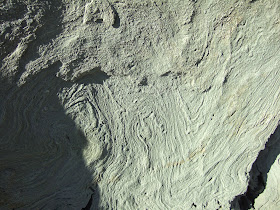I took a trip out to Decatur Island. The trip was non work related, but it did allow me to revisit a section of shoreline bluff I had observed 5 years ago (whidbey-formation) to see how the landslides and erosion I had observed then were progressing.
Slide areas outlined in red
Besides the landslides, the clear weather provided a nice view of Mount Baker and the remarkable lack of snow on the lower peaks fronting Baker.
There are a variety of glacial and non glacial units along this reach of shore called White Cliffs for the light colored tone of the units.
Glacial drift is present with fine silts and an occasional drop stone.
LiDAR and elevation and lack of very hard compaction leads me to believe these units are marine drift - that is the sediment was deposited on the sea floor from glacial ice floating on the sea surface.
A dominant unit is a finely layered silt which readily parts, but is otherwise rather hard. The ready ability to separate along the former bedding layers plays a significant role in the stability of these slopes.
Another player in the deep-seated landslides is the presence of peaty layers which in places were protruding through the surface of the beach suggesting that they may have been back rotated within a deep-seated landslide that extends below the tidelands. the peat also suggests that the units in this area are pre-glacial and the observation of an older glacial drift below the drift on the upper bluffs suggests that these pre-glacial sediments may be from the Whidbey inter glacial period 100,000 years plus in age.
However, the geology units at this site are not nicely layered cake. Some of the silts are highly deformed. Whetten (1975) described and photographed this exact same location shown below as an example of ice thrusting deformation and the site has not changed very appreciably since in comparing pictures.
One last geology observation was a cluster of rocks within younger glacial recessional deposits that I suspect may be from a buried block of ice that melted out leaving behind the cluster of cobbles. An alternative explanation could be that it was simply a narrow more energetic stream channel or somebody was dumping rocks from the bluff above.
The large landslide areas associated with the deep-seated landslides did not appear to have expanded since my last visit, but there was definite recent slope movement within the landslides as secondary failures have taken place within the layered silt zones as the material falls apart and the sand and gravesl overlying the units go along for the ride down the slopes.
Outside the area of large slides, classic shoreline erosion and under cutting of the bluff is taking place with a very recent bluff collapse that showed almost no erosion yet.















No comments:
Post a Comment